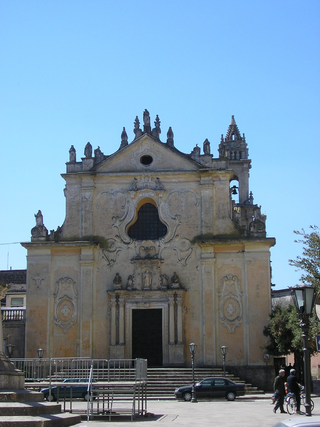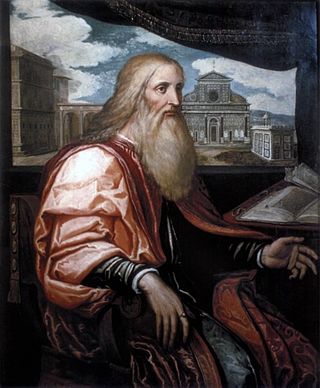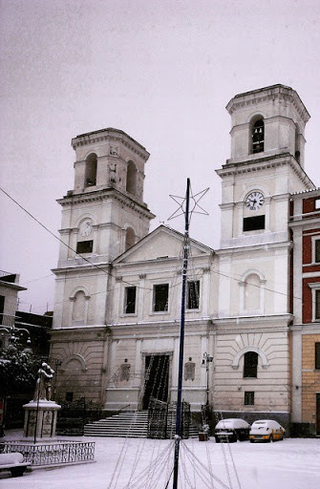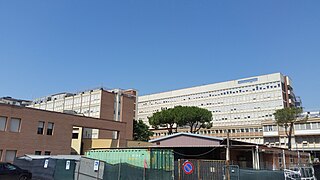
The Pazzi were a powerful family in the Republic of Florence. Their main trade during the fifteenth century was banking. In the aftermath of the Pazzi conspiracy in 1478, members of the family were banished from Florence and their property was confiscated; the family name and coat-of-arms were permanently suppressed by order of the Signoria.

Michelozzo di Bartolomeo Michelozzi was an Italian architect and sculptor. Considered one of the great pioneers of architecture during the Renaissance, Michelozzo was a favored Medici architect who was extensively employed by Cosimo de' Medici. He was a pupil of Lorenzo Ghiberti in his early years, and later collaborated with Donatello.

Prato is a city and comune in Tuscany, Italy, and is the capital of the Province of Prato. The city lies in the northeast of Tuscany, at an elevation of 65 metres (213 ft), at the foot of Monte Retaia. With 195,213 inhabitants as of 1 January 2023, Prato is Tuscany's second largest city and the third largest in Central Italy.

Poggio a Caiano is a town and comune in the province of Prato, Tuscany region Italy. The town, birthplace of Philip Mazzei, lies 9 kilometres (6 mi) south of the provincial capital of Prato.

Tricase is a town and comune in the province of Lecce, part of the Apulia region of south-east Italy. It is located in the Salento traditional region. An important hospital servicing the hinterland is Cardinale Giovanni Panico General Hospital, located in Tricase.

Giovanni di Cosimo I de' Medici, also known as Giovanni de' Medici the Younger, was an Italian cardinal.

Santa Maria presso San Satiro is a church in Milan. The Italian Renaissance structure (1476–1482) houses the early medieval shrine to Satyrus, brother of Saint Ambrose. The church is known for its false apse, an early example of trompe-l'œil, attributed to Donato Bramante.

Giovanni Panico was an Italian cardinal of the Catholic Church. He served as nuncio to several countries during his career, and was created a cardinal in 1962.

Innocenzo Cibo was an Italian cardinal and archbishop.

Bernardo Rucellai, also known as Bernardo di Giovanni Rucellai or Latinised as Bernardus Oricellarius, was a member of the Florentine political and social elite. He was the son of Giovanni di Paolo Rucellai (1403–1481) and father of Giovanni di Bernardo Rucellai (1475–1525). He was married to Nannina de' Medici, the elder sister of Lorenzo de' Medici, and was thus uncle to Popes Leo X and Clement VII, who were cousins. Oligarch, banker, ambassador and man of letters, he is today remembered principally for the meetings of the members of the Accademia Platonica in the Orti Oricellari, the gardens of his house in Florence, the Palazzo Rucellai, where Niccolò Machiavelli gave readings of his Discorsi.

The Oblate Sisters of the Holy Child Jesus are the members of a religious congregation of women founded in the 17th century, dedicated to the education and religious formation of poor girls. They use the suffix O.B.G. after their names.

Giovanni Rucellai, known by his name with the patronymic Giovanni di Paolo Rucellai, was a member of a wealthy family of wool merchants in Renaissance Florence, in Tuscany, Italy. He held political posts under Cosimo and Lorenzo de' Medici, but is principally remembered for building Palazzo Rucellai and the Rucellai Sepulchre, for his patronage of the marble façade of the church of Santa Maria Novella, and as author of an important Zibaldone. He was the father of Bernardo Rucellai (1448–1514) and grandfather of Giovanni di Bernardo Rucellai (1475–1525).

Medici is a historical drama television series created by Frank Spotnitz and Nicholas Meyer. The series was produced by Italian companies Lux Vide and Rai Fiction, in collaboration with Frank Spotnitz's Big Light Productions.
The Graviano family is a Sicilian Mafia clan, composed of four mafioso siblings: Benedetto, Filippo, Giuseppe and Nunzia. Their father was Michele Graviano, uomo d'onore that belonged to the Brancaccio Mafia family and was murdered by Gaetano Grado in 1982.

Domenico Sacchinelli was an abbot of the Catholic church. He is best known for having followed and helped Fabrizio Ruffo and the Sanfedisti army to restore the Kingdom of Naples and the Bourbon dynasty, after the short-lived Parthenopean Republic (1799). In 1836, after a few decades, he published his memoirs of that period, titled Memorie storiche sulla vita del cardinale Fabrizio Ruffo.

The Sanctuary of Saint Philomena is the main Catholic place of worship in Mugnano del Cardinale, in the province of Avellino. Inside, the remains of Saint Philomena have been kept since August 10, 1805. It is one of the nine sanctuaries of the Diocese of Nola.

The Misericordia Hospital is a hospital located in Grosseto, Tuscany, Italy.
Silvio Galizia was a Swiss architect and artist. Most of his life he lived and worked in Rome, Italy.

















